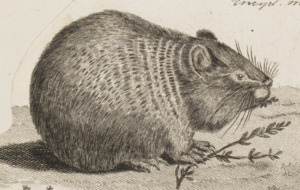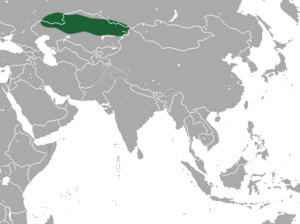Steppe pika facts for kids
Quick facts for kids Steppe pika |
|
|---|---|
 |
|
| Conservation status | |
| Scientific classification | |
| Genus: |
Ochotona
|
| Species: |
pusilla
|
| Subspecies | |
|
|
 |
|
| Steppe pika range | |
The steppe pika (Ochotona pusilla) is a small mammal. It belongs to the pika family, Ochotonidae. You can find it in the steppes of southern Russia and northern Kazakhstan.
Contents
About Steppe Pikas
The pika family, Ochotonidae, has only one group, Ochotona. This group includes 30 different living species. Pikas are a bit like rodents because they have strong front teeth for gnawing. But they also have an extra pair of these teeth in their upper jaw. Their teeth keep growing throughout their lives, so they need to chew a lot to wear them down. Pikas have excellent senses. They can smell, hear, and see very well.
The steppe pika is usually about 14.5 to 18.5 centimeters (about 6 to 7 inches) long. It has a very short tail and small, round ears. The fur is a grayish-brown color, with lighter tips on the hairs. Their coat gets even lighter in winter. One special thing about the steppe pika is its loud, high-pitched alarm call. This sound has earned it the nickname "whistling hare."
Scientists believe the steppe pika is a very old type of animal. Its ancestors lived a long, long time ago.
Reproduction and Life Cycle
Steppe pikas can have many babies. A mother pika can give birth to up to 13 young at one time. They can have litters three to five times each year. The number of babies might depend on how many other pikas are in the area. Pikas do not hibernate during the winter.
Where Steppe Pikas Live
Steppe pikas live in Central Asia. You can find them east of the Urals mountains. They live across southern Russia and northern Kazakhstan. A long time ago, during the Pleistocene Ice Age, they lived in many more places. Their range used to cover most of Europe. They survived in some parts of Europe until more recent times.
Steppe Pika Habitat and Habits
Steppe pikas like to live in steppes. These are wide, flat grasslands with tall grasses and bushes. These plants help them hide from enemies. Their natural enemies include foxes, corsacs, Turkestan polecats, and ermine. They also live in the foothills of river valleys.
Unlike some other pika species, the steppe pika is active at night. You are more likely to hear them than see them. Males make long, low trilling sounds. Females also "sing" to attract males and talk to other females. Steppe pikas live in groups. They build systems of tunnels underground with many entrances.
Pikas eat soft parts of juicy plants and small bushes. They usually find food close to their dens. One of their favorite plants is wormwood. Since they don't sleep through the winter, they start gathering grass early in the summer. They dry the grass and make it into haystacks. In late autumn, they move these haystacks into the main part of their underground home.
Steppe pikas only live on flat lands. If their fossils are found in mountains, it's usually because an owl dropped them there. Pikas are a good sign of how healthy a steppe ecosystem is. This is because they stay away from places where humans cause a lot of disturbance.
Population and Conservation
The number of steppe pikas has been going down. This is happening because of changes in the climate and more farming. Even though their numbers are decreasing, they are currently listed as "least concern." This means they are not in immediate danger of extinction. One place where they are protected is the Orenburgsky Zapovednik, a nature reserve. If a pika population grows very large, it can affect the plants in that area because they eat so much.


